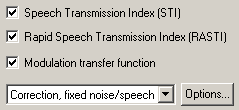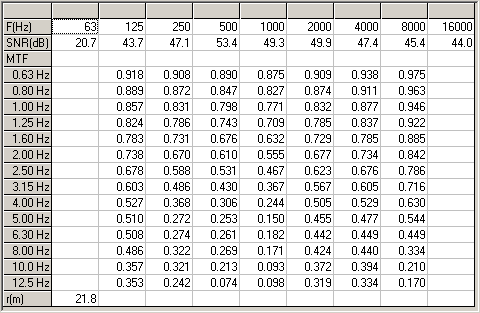
Speech transmission indices and modulation transfer function

The speech transmission index (STI) and the rapid version (RASTI) are single number measures based on both impulse response and signal-to-noise ratio in the room or speech transmission system. The standard IEC-60268-16 [1998, Sound system equipment – Part 16: Objective rating of speech intelligibility by speech transmission index.] describes the measures, which are based on weighted sums of modulation transfer function (MTF) values. The weights currently used in WinMLS are from the original definitions of STI and RASTI [T. Houtgast and H.J.M. Steeneken, "A review of the MTF concept in room acoustics and its use for estimating speech intelligibility in auditoria," J. Acoust. Soc. Am., vol. 77, pp. 1069-1077 (1985)]. The calculations are performed on the primary impulse response.
In the calculation of the MTF the impulse response is taken up to the truncation point determined in the decay curve formation, or the end of the impulse response, according to the integration option specified. The MTF is determined by FFT of the filtered and truncated impulse response, and the values at the exact 1/3-octave modulation frequencies specified are found by linear interpolation. This is a fast and very accurate method for all but extraordinary short impulse responses, and for these the modulation reduction for speech transmission is negligible anyway.
If the MTF is selected, it will be displayed in the grid as shown below.

If the background noise is low it will not affect the speech intelligibility. However, the background noise should be taken into account if the speech-to-noise ratio is less than 15 dB in the octave bands of interest. This is done in the compensation settings fond in Room Acoustics->Parameter Settings... and explained below
